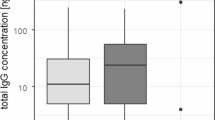Abstract
Background
To determine whether rubella virus is involved in the pathogenesis of Fuchs heterochromic iridocyclitis (FHI).
Methods
Fourteen patients (14 eyes) diagnosed with FHI based on characteristic ocular manifestations and eight control subjects were studied. Aqueous humor (AH) samples from 14 FHI patients and one vitreous sample from a FHI patient were analyzed for intraocular antibody production against rubella virus by calculation of the Goldmann–Witmer coefficient (GWC). Viral detection by nested polymerase chain reaction and isolation by culture in RK-13 cells were conducted in nine FHI patients. In addition to laboratory examinations, medical history of rubella virus vaccination was also obtained.
Results
Ten patients with FHI examined showed intraocular synthesis of rubella virus antibodies (GWC > 3). A high index of rubella virus antibody production was also found in the vitreous sample (GWC = 30.6). GWC in all control subjects were below detectable level. The rubella genome was detected in two of nine patients, and rubella virus was isolated from one of nine patients with FHI. None of the patients with FHI had been vaccinated against rubella.
Conclusions
Our laboratory data strongly suggest a relationship between FHI and rubella virus.



Similar content being viewed by others
References
Goto H, Mochizuki M, Yamaki K, Kotake S, Usui M, Ohno S (2007) Epidemiological survey of intraocular inflammation in Japan. Jpn J Ophthalmol 51:41–44
Tran VT, Auer C, Guex-Crosier Y, Pittet N, Herbort CP (1994) Epidemiological characteristics of uveitis in Switzerland. Int Ophthalmol 18:293–298
Franceschetti A (1955) Heterochromic cyclitis; Fuchs’ syndrome. Am J Ophthalmol 39:50–58
Mohamed Q, Zamir E (2005) Update on Fuchs’ uveitis syndrome. Curr Opin Ophthalmol 16:356–363
Velilla S, Dios E, Herreras JM, Calonge M (2001) Fuchs’ heterochromic iridocyclitis: a review of 26 cases. Ocul Immunol Inflamm 9:169–175
Regenbogen LS, Naveh-Floman N (1987) Glaucoma in Fuchs’ heterochromic cyclitis associated with congenital Horner’s syndrome. Br J Ophthalmol 71:844–849
Saari M, Vuorre I, Nieminen H (1978) Fuchs’s heterochromic cyclitis: a simultaneous bilateral fluorescein angiographic study of the iris. Br J Ophthalmol 62:715–721
Toledo de Abreu M, Belfort R Jr, Hirata PS (1982) Fuchs’ heterochromic cyclitis and ocular toxoplasmosis. Am J Ophthalmol 93:739–744
Barequet IS, Li Q, Wang Y, O’Brien TP, Hooks JJ, Stark WJ (2000) Herpes simplex virus DNA identification from aqueous fluid in Fuchs heterochromic iridocyclitis. Am J Ophthalmol 129:672–673
Chee SP, Jap A (2008) Presumed Fuchs heterochromic iridocyclitis and Posner–Schlossman syndrome: comparison of cytomegalovirus-positive and negative eyes. Am J Ophthalmol 146:883–889
Hammer H, Olah M (1975) Hypersensitivity towards alpha-crystalline in the heterochromia syndrome. Albrecht Von Graefes Arch Klin Exp Ophthalmol 197:61–66
van der Gaag R, Broersma L, Rothova A, Baarsma S, Kijlstra A (1989) Immunity to a corneal antigen in Fuchs’ heterochromic cyclitis patients. Invest Ophthalmol Vis Sci 30:443–448
Quentin CD, Reiber H (2004) Fuchs heterochromic cyclitis: rubella virus antibodies and genome in aqueous humor. Am J Ophthalmol 138:46–54
de Groot-Mijnes JD, de Visser L, Rothova A, Schuller M, van Loon AM, Weersink AJ (2006) Rubella virus is associated with Fuchs heterochromic iridocyclitis. Am J Ophthalmol 141:212–214
Birnbaum AD, Tessler HH, Schultz KL, Farber MD, Gao W, Lin P, Oh F, Goldstein DA (2007) Epidemiologic relationship between Fuchs heterochromic iridocyclitis and the United States rubella vaccination program. Am J Ophthalmol 144:424–428
Ruokonen PC, Metzner S, Ucer A, Torun N, Hofmann J, Pleyer U (2010) Intraocular antibody synthesis against rubella virus and other microorganisms in Fuchs’ heterochromic cyclitis. Graefes Arch Clin Exp Ophthalmol 248:565–571
Kimberlin DW (2002) Rubella virus. In: Richman DD, Whitley RJ, Hayden FG (eds) Clinical virology. ASM Press, Washington, DC, pp 1211–1225
Mets MB, Chhabra MS (2008) Eye manifestations of intrauterine infections and their impact on childhood blindness. Surv Ophthalmol 53:95–111
Katow S (2004) Surveillance of congenital rubella syndrome in Japan, 1978-2002: effect of revision of the immunization law. Vaccine 22:4048–4091
Nakayama T (2009) Laboratory diagnosis of measles and rubella infection. Vaccine 27:3228–3229
Labalette P, Caillau D, Grutzmacher C, Dessaint JP, Labalette M (2002) Highly focused clonal composition of CD8(+) CD28(neg) T cells in aqueous humor of fuchs heterochromic cyclitis. Exp Eye Res 75:317–325
Spriewald BM, Lefter C, Huber I, Lauer B, Wenkel H (2007) A suggestive association of fuchs heterochromic cyclitis with cytotoxic T cell antigen 4 gene polymorphism. Ophthalmic Res 39:116–120
Author information
Authors and Affiliations
Corresponding author
Rights and permissions
About this article
Cite this article
Suzuki, J., Goto, H., Komase, K. et al. Rubella virus as a possible etiological agent of Fuchs heterochromic iridocyclitis. Graefes Arch Clin Exp Ophthalmol 248, 1487–1491 (2010). https://doi.org/10.1007/s00417-010-1434-6
Received:
Revised:
Accepted:
Published:
Issue Date:
DOI: https://doi.org/10.1007/s00417-010-1434-6




